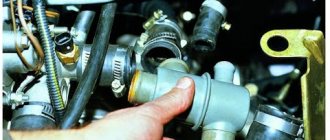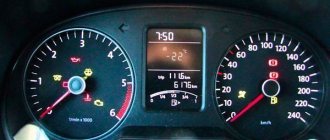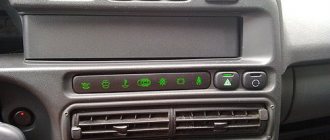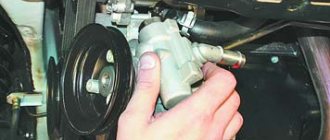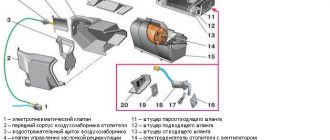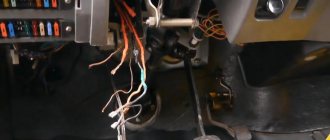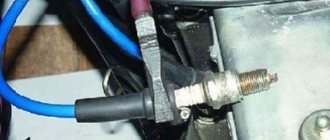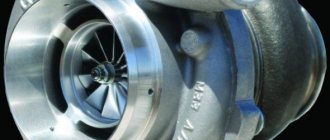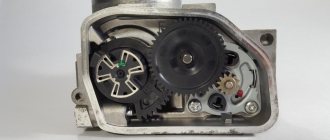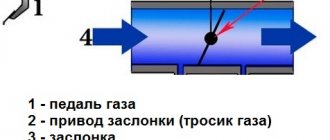The Lada Priora car enjoys the well-deserved love and respect of our compatriots. Good value for money, availability of spare parts and excellent maintainability make it the leader of the domestic automotive market. However, being the result of a Russian design, this car also has some disadvantages.
As you know, “Priora” is a deep restyling of the previous model – the 2110th. Therefore, most components and assemblies moved from the “ten”, including the design of the heating and ventilation systems for the interior. Most of the main parts of this system are “decimals”.
Principle of operation
First of all, you need to understand the principle of operation of the Priora heating system. The SAUO unit, which controls the heater, receives appropriate instructions from the temperature sensor located in the car's interior lamp. After that, it compares these readings with the temperature set by the driver.
If this difference is significant, the ACS sends a control pulse to the heater micromotor reducer, which controls the rotation of the damper. The direction and power of the flow of air supplied from the heater radiator to the passenger compartment depends on the magnitude of this rotation.
Signs of malfunction
If the air distribution damper does not work, this can lead to the following malfunctions in models without air conditioning:
- Only hot or cold air enters the car interior (regardless of the position of the heater control knobs);
- Instead of hot air, cold air enters the cabin.
In cars with Panasonic air conditioning, these cases are compounded by improper distribution of cooled air flows.
Failure of the distributor to take the desired position may be due to:
- with loosening of its fastenings and the gear motor drive;
- its deformation from hot air or breakage;
- adhesion to sealant residues.
In these cases, the Priora stove damper is blocked in one position. At the same time, clicks of the rotating mechanism are heard inside the car (the gearmotor that controls its position is knocking).
Lada Priora heater damper: how to remove and check. To repair, check and replace it, you will have to remove the plastic panel - the torpedo.
How to get to this mechanism without such difficulties? You can try to change the position of the regulator with a long screwdriver through the air duct grilles.
Some car enthusiasts, in order to avoid deformation, replace the standard one with a metal or wooden one.
In one of the issues of the automobile magazine "Behind the Wheel" it was proposed to replace the electronic control of the damper position with a simpler one - mechanical. As in old VAZ car models, its rotation can be adjusted using a system of levers and cables. It's not as convenient, but it's much more reliable.
Recommendations
Comments 42
He’ll overlook the antifreeze) so the first reason is the green thing... If necessary, I’ll write about it a little later
Thanks, I'll wait
And so, if the gearmotor is in working condition and does not jam, then the problem is with the Additional heater resistor. It is when this thing fails that hot air stops flowing into the cabin. On my Priora, the gear motor broke at one time, the characteristic sound of its operation was not heard... after replacement, everything was normal. The guy on the luxury Prior also had a problem with hot air, but he got around it by adding antifreeze, the pipe was leaking. Another friend had this problem, and it was his resistor that burned out. So first test the gear motor, if that’s not the problem, then change the resistor. They are located close to each other. Here is a link to the structure of the Priora stove, which was the first one I came across. Number 6 is that ill-fated green thing in the color picture)))) club-lada.rf/priora-remont/220-pechka-priora.html
Thanks a lot! I decided not to climb myself, I’ll go to the station.
The first reason is to check the antifreeze level. Next comes the damper gear motor, if when you turn the knob that switches hot cold air you can’t hear it working, then it’s it. If it switches, then the problem is (I don’t remember exactly what this green thing under the hood in the stove body is called), but it is this thing that is responsible for the hot air.
look at the pump, it's probably leaking brains
Perhaps it was the pump I had like this, the impeller fell off and turned, it was also blowing cold, I dismantled the stove, changed the gear motor, radiator, and then as it got warmer the car began to warm up, I changed the pump and that’s it Tashkent
I'm not inclined towards the pump. I’ve been driving like this for a year now, I think it would prove itself in the summer...
Class! Thank you! Maybe I'll change it today!))))
Option 1 - the problem is in the gear motor gear, it does not turn until it warms up. Option 2 - the problem is in the temperature sensor in the ceiling, it is this that regulates the position of the heater damper, depending on the temperature in the cabin and the desired temperature on the regulator. If you turn off this sensor, then the position of the damper will correspond to the position on the regulator.
It doesn't need to warm up to turn over. It is already lubricated with lubricant in a sealed housing. There’s nothing special for her to warm up there. It won't turn if its teeth break. Desynchronization of the position of the damper and the control knob occurs precisely because the sensor sends a signal to an already obviously broken regulator. A gear with broken teeth jumps over normal ones. Over time, the next teeth will break, and as a result an unpredictable wedge
Are you treating from photographs?
necessary, not necessary - the fact is the fact that the damper turns only when the engine is warmed up. What prevents the gear motor from rotating until it warms up? and it rotates... not immediately, but much later - which means warming up is important. and if it had been teeth, it would have turned right away. without waiting for it to warm up. A gear with broken teeth jumps over normal ones - complete nonsense. disassemble the gear motor at least once. the teeth there do not break, but the edges are eaten away and that is why a wedge appears.
There is no desynchronization between the handle and the sensor; it contains the principle of a constantly adjusting heater damper, based on the readings of the interior temperature sensor. Let’s say we want 20+ and we have 12, then the gear motor will open the damper as much as possible, then as the interior warms up, as it warms up it lowers it to a position in which the flow of hot air will maintain 20+ in the cabin.
not from the photo, but from experience, I myself changed 3 of these gearboxes; all of them had 3 broken teeth on the selector gear, I took them apart and saw how they were arranged inside, the teeth were broken, not ground off. The gearbox does not need heating to operate. The gearbox starts moving as soon as you start the car - IMMEDIATELY look for a new position from the one in which it remained before turning off, taking into account the changed weather realities, as shown by the sensor in the cabin. It moves immediately, without warming up. And if you left it at 20+ and it’s -10 outside in the morning, then in order to heat the solon again to 20+, the damper will start from a different position, immediately setting it to 20+ and not the maximum, this is not required of it. And it will begin to move slowly after the interior has warmed up to 20+, reducing the warm air, thereby maintaining 20+. And it is during the initial start-up that the teeth in the gearbox break - for what reason - that’s another matter, wear there or a high starting current or something else. When 1 tooth is broken, it’s not scary, but when 2 or more are broken, it begins to jump or slip, causing a mismatch between the position of the damper and the control knob, and when, for example, you want heat, the lack of teeth does not allow you to move the damper to this position. So disassemble the gearbox yourself, just break 2-3 teeth, rotate the broken gear against the whole one and see how a discrepancy arises. As a result, the broken gear will take such a position that neither the manual control nor the sensor will move it.
Principle of operation
First of all, you need to understand the principle of operation of the Priora heating system. The SAUO unit, which controls the heater, receives appropriate instructions from the temperature sensor located in the car's interior lamp. After that, it compares these readings with the temperature set by the driver.
If this difference is significant, the ACS sends a control pulse to the heater micromotor reducer, which controls the rotation of the damper. The direction and power of the flow of air supplied from the heater radiator to the passenger compartment depends on the magnitude of this rotation.
Signs of malfunction
If the air distribution damper does not work, this can lead to the following malfunctions in models without air conditioning:
- Only hot or cold air enters the car interior (regardless of the position of the heater control knobs);
- Instead of hot air, cold air enters the cabin.
In cars with Panasonic air conditioning, these cases are compounded by improper distribution of cooled air flows.
Types of breakdowns
Failure of the distributor to take the desired position may be due to:
- with loosening of its fastenings and the gear motor drive;
- its deformation from hot air or breakage;
- adhesion to sealant residues.
In these cases, the Priora stove damper is blocked in one position. At the same time, clicks of the rotating mechanism are heard inside the car (the gearmotor that controls its position is knocking).
Lada Priora heater damper: how to remove and check. To repair, check and replace it, you will have to remove the plastic panel - the torpedo.
How to get to this mechanism without such difficulties? You can try to change the position of the regulator with a long screwdriver through the air duct grilles.
Some car enthusiasts, in order to avoid deformation, replace the standard one with a metal or wooden one.
In one of the issues of the automobile magazine "Behind the Wheel" it was proposed to replace the electronic control of the damper position with a simpler one - mechanical. As in old VAZ car models, its rotation can be adjusted using a system of levers and cables. It's not as convenient, but it's much more reliable.
The stove does not work on the Lada Priora (reasons and repairs)
With the onset of cold weather, the first malfunctions of the Lada Priora heater begin to appear. Situations may be different; in one case there may be problems with the fan, in another with the dampers, etc. Today we will tell you how to properly repair a stove on a Priora with your own hands.
Engine cooling system problems?
As practice shows, most problems with the Priora stove occur due to the ESD (engine cooling system).
In this case, the procedure is as follows:
1.
We check the coolant level in the expansion tank so that it is between o and “MAX”. If coolant has to be added all the time, then the cooling system is leaking somewhere. You should carefully inspect all pipes for leaks, and also tighten the clamps. By the way, in order for warm air to enter the cabin faster, many car enthusiasts in winter specially add coolant only to the “MIN” mark. After all, the less liquid there is in the system, the faster it will heat up.
2.
We check the coolant circulation in the SOD, paying attention to the expansion tank.
If there is no antifreeze circulation, or it is not sufficient, then the pump may be faulty (it should be replaced) or the cooling system may be clogged.
3.
Checking the thermostat. We warm up the engine to 75 degrees and feel the upper radiator pipe (in diagram No. 13), if it is cold, then the coolant circulates only in a small circle, the thermostat should be replaced with a new one.
If the stove blows cold air, then the reason may be airing of the SOD.
Problems with the heater elements of Lada Priora?
Content
Why doesn't the heater work and blows cold air on the Priora? There are many reasons for this. In descending order of frequency of cases, they can be arranged as follows:
- The stove damper is stuck. It does not open and does not allow warm air into the cabin. By the way, the opposite option is also possible: if it is closed in the open position, you begin to feel like you are in a sauna;
- The heating gear motor is broken;
- The stove control unit does not work;
- Problems in the engine cooling system;
- The temperature sensor in the cabin has broken down, and the heating system simply does not know that you are cold. Again, in a similar but opposite case, it may be hot.
The stove on the Priora does not work - possible causes and their elimination
January 16, 2017
The Lada Priora car enjoys the well-deserved love and respect of our compatriots. Good value for money, availability of spare parts and excellent maintainability make it the leader of the domestic automotive market. However, being the result of a Russian design, this car also has some disadvantages.
As you know, “Priora” is a deep restyling of the previous model – the 2110th. Therefore, most components and assemblies moved from the “ten”, including the design of the heating and ventilation systems for the interior. Most of the main parts of this system are “decimals”.
Therefore, such unification is very helpful during repairs. Unfortunately, this feature backfires when malfunctions occur. There are quite frequent cases when the stove on a Priora does not work. The situations are different. In one case there may be problems with the fan, in another - with the dampers, etc.
Recommendations
Comments 19
A month ago I solved this problem for myself. True, I had to tinker. You will still have to remove the motor. But first, check the snail itself through the hatch in the control compartment for foreign objects. If everything is clean, then try turning on the stove and turning the impeller by hand. But most likely it will have to be removed. Removal option 2. Disconnect the condenser or not disconnect it. You can't just stick the motor out there. Using a grinder, I carefully cut the plastic from the air conditioner pipes up and removed the left side of the plastic. The snail came apart easily, I fiddled with the motor a little.
It was the same story, a blow to the stove still turned on the motor, but for the time being. Then he stopped completely. The brushes on my fan motor are worn out. This is a very troublesome problem, if according to the instructions, the repair is very expensive, since it is necessary to remove the entire climate control unit from under the hood (drain the air conditioner, frieze, etc.) But there is another way, you will have to cut the plastic trim of the engine compartment in two places to get it out motor, brushes can be bought for about 500 rubles, I bought some for a foreign car, they fit best. If you’re interested, I can tell you in more detail) I myself spent a very long time and persistently cursing at AVTOVAZ’s designers when I was doing all this.
It will be useful: Adjusting the valves of grant frets 8 and 16 valves with your own hands: video instructions
try to look at the chip under the frill of the driver's wiper. I had the same problem due to overheating and loss of contact in this chip)
Today I’ll take a look and see what the chip is on the driver’s side, i.e. so far from the motor itself?
yes, on the driver's side)
The brushes in the electric motor may jam. If after knocking it starts working, this is the first sign.
When knocking, the motor does not come to life... I tried it, it didn’t help...
It was so. The chip that goes to the fan motor melted. Replaced the connector. All is good. And it also happened that the knock would work. Since it was a bitter winter, we started looking at the first opportunity.
A friend had this happen. The negative wire came off, there was no contact + there are three problems with the motor itself, the switching resistor. look at the diagram, check the voltage. Did it go to the block, then to the motor?
Directly check the motor by applying power to the connector, and then based on the results. Is there a condo?
To apply voltage directly to the motor, do you need to remove the black plastic under the wipers? Priora with Conder
Preparatory stage
Troubleshooting the heater should begin provided that the power unit and engine cooling system are in order to eliminate their influence. To do this, you need to make sure that the antifreeze is poured in the proper amount, the engine is in good condition and is functioning normally. And after that, find out why the stove on the Priora does not work. First, check the coolant level in the expansion tank. Next, you need to start the engine and warm it up to operating temperature. After this, you need to check the serviceability of the thermostat - feel the thick hoses that go from it to the car radiator.
The top one should gradually become hot. If the rubber hose is still cold, the thermostat is faulty. In this case, you can continue working only after replacing this element. Fortunately, its cost is low.
Another reason why the engine may not warm up to operating temperature is a leaky expansion tank cap. It should keep excess pressure in the system. Often, simply replacing this cover can completely eliminate the problem.
On the Priora, unlike the Tens, the cooling system is organized differently. And the formation of an air lock there is practically excluded. It can occur when the system is leaking or when antifreeze is poured into a completely empty expansion tank. This can be fixed quite simply. You need to drive your front wheels up some hill in a warm car and vigorously apply the gas in place. The expansion tank cap should be removed.
Clogged filter
Experienced Prior owners have developed an algorithm of actions to find out where the heating system is leaking.
First approach
Before all checks, you need to make sure that the fan is working - it would be unreasonable to go deeper if the main element does not spin. The next steps are as follows.
- The engine heats up to the desired temperature;
- The pipes leading to the heater are probed. Both are hot - okay, one is at ambient temperature - which means there is no filler circulation;
- The hood opens, the tap is located and turns to another position. If it gets stuck, you will have to immediately soak it with WD-40.
- The system is checked for leaks. The detected ones are eliminated: a constant lack of coolant is also the cause of cold airflow;
- The tap is working, there is no leak - the plug is removed from the tank and the liquid level is checked. Often an air lock forms in the tank; in this case, the coolant is topped up to normal, and the gas pedal is pressed sharply several times. The fluid circulation will resume and squeeze the plug out of the reservoir;
- To make the last step more effective, it is better to drive the front end onto the nearest hillock so that the car’s radiator is lower than the stove radiator.
Second approach
When (or if) both pipes are filled with hot liquid, we move on to the dampers.
- Again you will have to climb under the hood, this time to observe the operation of the damper;
- If it is warped or jammed, you can try to gently shake it with your hand from inside the cabin. To do this, remove the central deflector and unscrew the plastic guides to reach the stuck element. Access is only possible for a thin limb, so it is advisable to invite a female person to the procedure if she does not mind;
- If there are serious problems with the damper (the fastenings have rusted, the plastic has warped due to temperature or it has cracked), alas, you will be faced with difficult work: you will have to disassemble half of the heating system.
Heater radiator malfunctions
Another reason why the heater in a Lada Priora car does not work (cold air blows from the deflectors) may be the accumulation of dirt in the heat exchanger. When the cooling system operates, deposits accumulate in the engine block itself over time, which are then spread throughout the entire system, including into the heater radiator. These deposits prevent it from working effectively. The system will heat the air worse. In this case, the heater radiator can be replaced entirely. It is removed from the engine side. Before starting work, be sure to drain the antifreeze from the cooling system. Then dismantle the windshield wiper arms, the frill trim and move aside part of the soundproofing shield. After this, disassemble the stove body, disconnect the wires, remove the fan motor along with the impeller and remove the heat exchanger, disconnecting the supply hoses from it.
see also
Comments 25
I didn’t try to check the relay first, if it burns out then the fan runs constantly
Most likely, a transistor has broken through in the final stage of the speed controller. This is a well-known product under the frill, almost in the center on two screws. You can check by simply removing the connector from it. If, when you remove the connector from it, the fan turns on only when the regulator is set to maximum speed, then you can repair this product and replace the transistor.
That’s right, if you remove the connector it works in the last position
Most likely, a transistor has broken through in the final stage of the speed controller. This is a well-known product under the frill, almost in the center on two screws. You can check by simply removing the connector from it. If, when you remove the connector from it, the fan turns on only when the regulator is set to maximum speed, then you can repair this product and replace the transistor.
I took it off and then what should I do with it?
And then you can repair it. Replace the power transistor. How to replace? Disassemble the assembly, unsolder the board from the thermal fuse and power transistor. There will be a transistor on the radiator that needs to be replaced, and a thermal fuse pressed by the transistor to the radiator. The name of the transistor is written on its body. The transistor can be bought at the Radio Components store. It costs about 150-200 rubles.
He's there inside as I understand it
Yes, inside. Through the square hole that can be seen in the photo you can see what will interfere with disconnecting the board. These are 3 thick contacts in a row, these are the transistor terminals, and two thermal fuse terminals, these are two thin wires with a black tube. Carefully remove any solder from the pins and disconnect the board.
I'll go to an electrician tomorrow and let them resolder it
And that's true. I usually have a couple of replacement nodes so as not to waste time. The car arrives, I change the knot and release it.
Yes, inside. Through the square hole that can be seen in the photo you can see what will interfere with disconnecting the board. These are 3 thick contacts in a row, these are the transistor terminals, and two thermal fuse terminals, these are two thin wires with a black tube. Carefully remove any solder from the pins and disconnect the board.
I just don’t know where in our glorious city to buy this miracle
In the Radio Components store, or at the radio market.
in Murom such luxury cannot be found in radio components; we have nothing but batteries
forum.murom.ru/read.php?10.74518 maybe help? If you don't find it yourself, I can send it first class.
thank you very much, I'll keep that in mind
Most likely, a transistor has broken through in the final stage of the speed controller. This is a well-known product under the frill, almost in the center on two screws. You can check by simply removing the connector from it. If, when you remove the connector from it, the fan turns on only when the regulator is set to maximum speed, then you can repair this product and replace the transistor.
Finally at least one sensible comment
There is a little thing in the speed controller. I don’t remember exactly what it’s called, something like a “thermistor”. I had the same situation. I bought a thermistor at the radio market, it costs about 10-20 rubles. It looked different from the factory one, but the main thing was that it was designed for the same temperature. I went to a radio amateur I knew, soldered this resistor and everything worked. The reason that this resistor burned out was that the leaves from the trees almost completely clogged the cabin filter. After that, I placed a mesh in front of the air intake under the frill.
The heater motor resistor burned out. When it burns out the stove works at maximum speed...
But even in the off position the stove continues to work
The speed of the stove is controlled by a resistor; when it burns, the voltage is directly supplied. Actually, there are two rules - if the motor does not work, check the fuse, if it works at maximum, then the resistor...
Winter for a motorist results in a lot of unpleasant problems. What can we say about the increased danger associated with icy road surfaces, frozen door handles or a power unit that does not want to start. But even if you managed to sort out all the problems mentioned above, you still can’t go far in a car when the temperature inside the cabin is only a couple of degrees higher than outside, and even then only due to the warm air we exhale. A nightmare for any Lada Priora owner. Stove repair is a surefire diagnosis of a sudden problem, and we know how to deal with it.
Additional resistance fault
There are often situations when the heater switch on a Priora does not work - the motor operates only at fourth speed or only at first. The reason here may be additional resistance, which slows down the rotation speed of the stove fan.
This resistance is a block of resistors (the fourth speed is direct, without deceleration). It is located in the heater housing on the left side and is secured with two screws. This resistance is also unified with many domestic models (2110, Kalina, Chevrolet Niva).
Incorrect operation of the cabin temperature sensor
There is another reason why the stove on the Priora does not work correctly. It occurs due to a malfunction of the cabin temperature sensor. It is located in the ceiling lamp.
The element, measuring the air temperature in the cabin, gives a command to the damper gearbox to open or close. This way the microclimate in the cabin is regulated. Its serviceability should also be checked.
Heating system elements (stoves)
The fact that the Priora stove is 95% similar to the “ten” can be seen by the catalog numbers:
- Heater assembly (2170-8101012 or 2111-8101012-10).
- Air flow distribution gearmotor (2170-8127100). Distributes air flow to the feet/face/windshield. Located inside the dashboard.
- Interior air temperature sensor (11186-8128050). Located on the ceiling.
- Heater control controller (HCU) or stove control unit (21703-8128020). The block on which the driver sets the operating parameters of the stove. Located on the panel.
- Additional resistor or additional resistor (2123-8118022). Determines the rotation speed of the stove fan. Secured in the engine compartment.
- Electric heater fan (2111-8118020). Located under the hood.
- Heater damper motor reducer (2110-8127200). Distributes air flows into the cabin (outside/heater radiator). Inside the heater assembly.
- Air filter (2110-8122020).
- Heater radiator (2110-8101060). Located inside the heater.
A malfunction of one of these elements causes problems in the operation of the stove.
Malfunctions of the heater control unit
The operation of the heating system is completely dependent on the heater control unit. It distributes air flows, the intensity of airflow to different zones of the cabin and the temperature regime. If it fails, the stove naturally stops working.
There may be malfunctions of the switches (“twisters”). The malfunction of the control unit should be checked last, since this unit is electronic and can rarely be repaired. Therefore, to check it, it is advisable to temporarily replace it with one that is known to work, borrowing it from a friend or in a store with a deposit.
Features of the heater in a Priora with air conditioning
A common reason why the stove (Priora with air conditioning) does not work is the failure of the speed control unit (RFV), which is located on the heater housing under the hood. It regulates the intensity of the fan motor. If it fails, the stove stops functioning altogether or operates only at fourth speed.
The cause of the malfunction is often prolonged operation of the heater in recirculation mode (with the air damper closed) and, as a consequence, its overheating. Therefore, its performance should also be checked.
Problems with the damper gear motor or fan motor
A common malfunction on a Lada Priora car is that the heater does not work. No air blowing at all.
First, you should make sure that the heater motor is working - at least cold air should be blowing from the deflectors. If not, then you need to check the integrity of fuse F9.
If it is intact, it means the stove fan is not working. "Priora" is equipped with a "ten" fan. Therefore, removing it exactly repeats the procedure on the “ten”. In some cases, the fan does not spin because leaves or other foreign objects have gotten between the impeller and its housing, which can block rotation. In this case, you can hear a characteristic hum.
Cold air can also come out of the deflectors because the gear motor that controls the damper that blocks the flow of hot air is not working. It is also accessible from under the hood.
Often the cause of gearmotor failure is oxidation of conductive contacts. They need to be cleaned with sandpaper by disassembling the body. You should also pay attention to the strength of the air flow. If even at maximum speed the air is blowing weakly, it may be a clogged cabin filter. It is located under the hood in the heater housing and creates additional interference.

